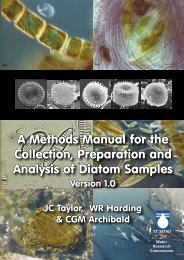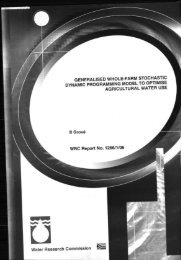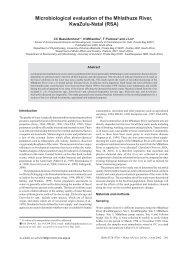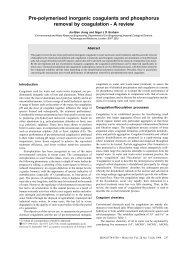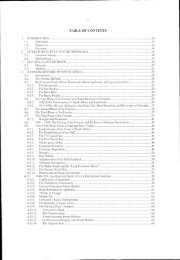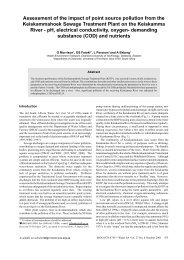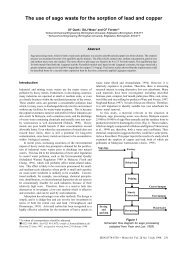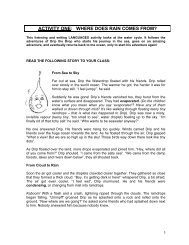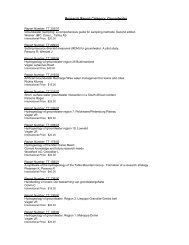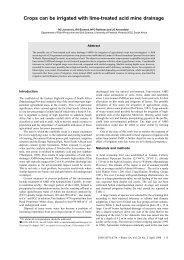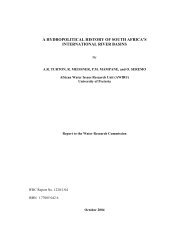and the Efficacy of Pit Latrine Additives - Water Research Commission
and the Efficacy of Pit Latrine Additives - Water Research Commission
and the Efficacy of Pit Latrine Additives - Water Research Commission
- No tags were found...
Create successful ePaper yourself
Turn your PDF publications into a flip-book with our unique Google optimized e-Paper software.
3 PROCESSES IN PIT LATRINES<br />
The information presented in Chapter 2 provides some insight into <strong>the</strong> management <strong>of</strong> pit latrines from a<br />
practical perspective. However, <strong>the</strong> formal scientific literature yields very little information on <strong>the</strong> processes<br />
that occur within a pit latrine, <strong>and</strong> specifically on <strong>the</strong> relative importance <strong>of</strong> <strong>the</strong> different categories <strong>of</strong><br />
processes that occur. Based on a critical review <strong>of</strong> <strong>the</strong> available literature, discussions with experienced pit<br />
latrine practitioners (including people involved in designing, building <strong>and</strong> emptying pit latrines) <strong>and</strong> <strong>the</strong> results<br />
<strong>of</strong> <strong>the</strong> various studies that were undertaken as part <strong>of</strong> this project, a general <strong>the</strong>ory <strong>of</strong> what happens in a pit<br />
latrine was developed. This <strong>the</strong>ory is presented below, followed by <strong>the</strong> findings <strong>of</strong> <strong>the</strong> studies within this<br />
project <strong>and</strong> <strong>the</strong>ir contribution to <strong>the</strong> general <strong>the</strong>ory <strong>of</strong> processes in pit latrines.<br />
3.1 General <strong>the</strong>ory <strong>of</strong> <strong>the</strong> processes in a pit latrine<br />
In order to underst<strong>and</strong> what occurs in a pit latrine, it is necessary to have an appreciation <strong>of</strong> what pit latrine<br />
contents consist <strong>of</strong> <strong>and</strong> what kinds <strong>of</strong> conversion processes can occur in <strong>the</strong> pit latrine.<br />
Between 75% <strong>and</strong> 80% <strong>of</strong> <strong>the</strong> mass <strong>of</strong> faeces from a relatively healthy individual is moisture. This is slightly<br />
more than <strong>the</strong> amount <strong>of</strong> moisture commonly measured in VIP sludge. Up to 80% <strong>of</strong> <strong>the</strong> organic material in<br />
faeces is biodegradable. Faeces contain a large mass <strong>of</strong> active micro-organisms (up to 30% <strong>of</strong> <strong>the</strong> mass <strong>of</strong><br />
faeces on a dry basis), <strong>and</strong> some portion <strong>of</strong> <strong>the</strong> rest <strong>of</strong> <strong>the</strong> organic material may be considered to be readily<br />
biodegradable. The remainder <strong>of</strong> <strong>the</strong> biodegradable material will be slowly biodegradable, i.e. will undergo<br />
relatively slow conversion processes before being completely degraded within <strong>the</strong> pit latrine. A substantial<br />
portion <strong>of</strong> <strong>the</strong> faecal material will consist <strong>of</strong> intact cellular material. This may be from active micro-organisms<br />
that make up <strong>the</strong> 30% reported above, from dead or inactive micro-organisms originating from <strong>the</strong> digestive<br />
system, or <strong>the</strong> cellular matter may originate from partially digested plant or animal tissue that has formed part<br />
<strong>of</strong> <strong>the</strong> diet <strong>of</strong> <strong>the</strong> person producing <strong>the</strong> faeces.<br />
It appears that when faeces are added to a pit latrine, <strong>the</strong>y undergo a period <strong>of</strong> rapid degradation in which<br />
micro-organisms present in <strong>the</strong> faeces <strong>and</strong> those present on <strong>the</strong> surface <strong>of</strong> <strong>the</strong> pit latrine contents cause<br />
rapid aerobic degradation <strong>of</strong> readily biodegradable organic material. Thus a considerable portion <strong>of</strong> <strong>the</strong><br />
biologically degradable portion <strong>of</strong> faeces disappears through aerobic bioconversion processes as it lies on<br />
<strong>the</strong> surface <strong>of</strong> <strong>the</strong> pit contents.<br />
Since <strong>the</strong> rate <strong>of</strong> accumulation in <strong>the</strong> pit is slow relative to <strong>the</strong> rate <strong>of</strong> degradation in this first rapid<br />
degradation phase, <strong>the</strong> amount <strong>of</strong> material on <strong>the</strong> pit surface that can be considered to be similar in<br />
composition to fresh faeces is negligibly small compared to <strong>the</strong> amount <strong>of</strong> material accumulated in <strong>the</strong> pit.<br />
The readily biodegradable components in <strong>the</strong> faeces have thus already been consumed on <strong>the</strong> surface <strong>of</strong><br />
<strong>the</strong> pit contents.<br />
In a well-designed pit latrine, <strong>the</strong>re is a constant motion <strong>of</strong> air through <strong>the</strong> pedestal, into <strong>the</strong> pit <strong>and</strong> out <strong>of</strong> <strong>the</strong><br />
vent pipe. Thus <strong>the</strong>re is a constant supply <strong>of</strong> oxygen to <strong>the</strong> top surface <strong>of</strong> <strong>the</strong> pit contents through contact<br />
with air, <strong>and</strong> aerobic processes may occur in <strong>the</strong> top layer <strong>of</strong> pit latrine contents. Except for an area <strong>of</strong> a few<br />
square centimetres on <strong>the</strong> top <strong>of</strong> <strong>the</strong> pile, <strong>the</strong> pit latrine contents at <strong>the</strong> surface will have little fur<strong>the</strong>r readily<br />
biodegradable material present. The presence <strong>of</strong> oxygen at <strong>the</strong> surface will <strong>the</strong>refore facilitate fur<strong>the</strong>r, slow<br />
aerobic degradation <strong>of</strong> some <strong>of</strong> <strong>the</strong> remaining slowly biodegradable components. During aerobic<br />
degradation, organic material is converted to carbon dioxide <strong>and</strong> new micro-organism cell material.<br />
Once organic material has been covered over by new pit contents, <strong>the</strong> material becomes anaerobic through<br />
lack <strong>of</strong> oxygen, <strong>and</strong> <strong>the</strong> rate <strong>of</strong> degradation drops dramatically. This is due to two effects. Firstly, readily<br />
biodegradable organic material has been depleted; secondly, anaerobic digestion processes, i.e. those that<br />
11



